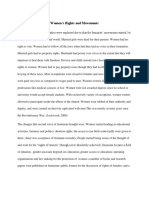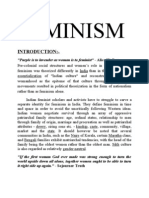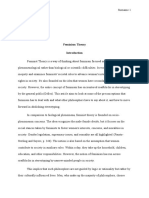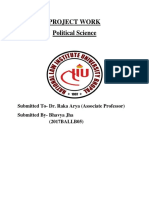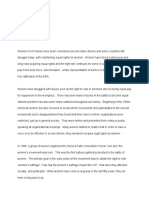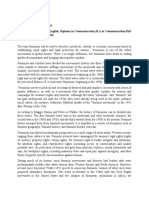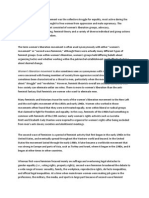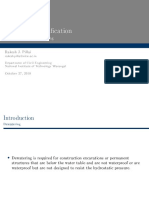Women's Rights
Women's Rights
Uploaded by
Shawn Dustin CoscolluelaCopyright:
Available Formats
Women's Rights
Women's Rights
Uploaded by
Shawn Dustin CoscolluelaCopyright
Available Formats
Share this document
Did you find this document useful?
Is this content inappropriate?
Copyright:
Available Formats
Women's Rights
Women's Rights
Uploaded by
Shawn Dustin CoscolluelaCopyright:
Available Formats
WOMEN A woman (irregular plural: women) is a female human.
The term woman is usually reserved for an adult, with the term girl being the usual term for a female child or adolescent. However, the term woman is also sometimes used to identify a female human, regardless of age, as in phrases such as "Women's rights". Womanhood is the period in a female's life after she has transitioned from girlhood, at least physically, having passed the age of menarche. Many cultures have rites of passage to symbolize a woman's coming of age, such as confirmation in some branches of Christianity, bat mitzvah in Judaism, or even just the custom of a special celebration for a certain birthday (generally between 12 and 21). The word woman can be used generally, to mean any female human, or specifically, to mean an adult female human as contrasted with girl. The word girl originally meant "young person of either sex" in English; it was only around the beginning of the 16th century that it came to mean specifically a female child. Nowadays girl sometimes is used colloquially to refer to a young or unmarried woman. During the early 1970s feminists challenged such use, and use of the word to refer to a fully grown woman may cause offence. In particular, previously common terms such as office girl are no longer used In many prehistoric cultures, women assumed a particular cultural role. In hunter-gatherer societies, women were generally the gatherers of plant foods, small animal foods, fish, and learned to use dairy products, while men hunted meat from large animals. In more recent history, the gender roles of women have changed greatly. Traditionally, middleclass women were typically involved in domestic tasks emphasizing child care. For poorer women, especially working class women, this often remained an ideal, as economic necessity compelled them to seek employment outside the home. The occupations that were available to them were, however, lower in pay than those available to men. As changes in the labor market for women came about, availability of employment changed from only "dirty", long houred factory jobs to "cleaner", more respectable office jobs where more education was demanded, women's participation in the U.S. labor force rose from 6% in 1900 to 23% in 1923. These shifts in the labor force led to changes in the attitudes of women at work, allowing for the revolution which resulted in women becoming career and education oriented. Movements advocate equality of opportunity for both sexes and equal rights irrespective of gender. [specify] Through a combination of economic changes and the efforts of the feminist movement, in recent decades women in most societies now have access to careers beyond the traditional homemaker. Many observers, including feminist groups, maintain that women in industry and commerce face glass ceilings. WOMENS RIGHTS The term women's rights refers to freedoms and entitlements of women and girls of all ages. These rights may or may not be institutionalized, ignored or suppressed by law, local custom, and behavior in a particular society. These liberties are grouped together and differentiated from broader notions of human rights because they often differ from the freedoms inherently possessed by or recognized for men and boys, and because activists for this issue claim an inherent historical and traditional bias against the exercise of rights by women and girls. Issues commonly associated with notions of women's rights include, though are not limited to, the right: to bodily integrity and autonomy; to vote (suffrage); to hold public office; to work; to fair wages or
equal pay; to own property; to education; to serve in the military or be conscripted; to enter into legal contracts; and to have marital, parental and religious rights. Women and their supporters have campaigned and in some places continue to campaign for the same rights as men. In the subsequent decades women's rights again became an important issue in the English speaking world. By the 1960s the movement was called "feminism" or "women's liberation." Reformers wanted the same pay as men, equal rights in law, and the freedom to plan their families or not have children at all. Their efforts were met with mixed results. In the last three decades of the 20th century, Western women knew a new freedom through birth control, which enabled women to plan their adult lives, often making way for both career and family. The movement had been started in the 1910s by US pioneering social reformer Margaret [39] Sanger and in the UK and internationally by Marie Stopes. Over the course of the 20th century women took on greater roles in society such as serving in government. In the United States some served as U.S. Senators and others as members of the U.S. Cabinet. Many women took advantage of opportunities in higher education. In the United States at the beginning of the 20th century less than 20% of all college degrees were earned by women. By the end of the century this figure had risen to about 50%. Progress was made in professional opportunities. Fields such as medicine, law, and science opened to include more women. At the beginning of the 20th century about 5% of the doctors in the United States were women. As of 2006, over 38% of all doctors in the United States were women, and today, women make almost 50% of the medical student population. While the numbers of women in these fields increased, many women still continued to hold clerical, factory, retail, or service jobs. For example, they worked as office assistants, on assembly lines, or as cooks. FEMINISM The term feminism can be used to describe a political, cultural or economic movement aimed at establishing more rights and legal protection for women. Feminism involves political and sociological theories and philosophies concerned with issues of gender difference, as well as a movement that advocates more gender-specific rights for women and campaigns for women's rights and interests. Although the terms "feminism" and "feminist" did not gain widespread use until the 1970s, they were already being used in the public parlance much earlier; for instance, Katherine Hepburn speaks of the "feminist movement" in the 1942 film Woman of the Year. According to Maggie Humm and Rebecca Walker, the history of feminism can be divided into three waves. The first feminist wave was in the nineteenth and early twentieth centuries, the second was in the 1960s and 1970s, and the third extends from the 1990s to the present. Feminist theory emerged from these feminist movements. It is manifest in a variety of disciplines such as feminist geography, feminist history and feminist literary criticism. Feminism has altered predominant perspectives in a wide range of areas within Western society, ranging from culture to law. Feminist activists have campaigned for women's legal rights (rights of contract, property rights, voting rights); for women's right to bodily integrity and autonomy, for abortion rights, and for reproductive rights (including access to contraception and quality prenatal care); for protection of women and girls from domestic violence, sexual harassment and rape; for workplace rights, including maternity leave and equal pay; against misogyny; and against other forms of gender-specific discrimination against women.
During much of its history, most feminist movements and theories had leaders who were [15][16][17] predominantly middle-class white women from Western Europe and North America. However, at least since Sojourner Truth's 1851 speech to American feminists, women of other races have ] proposed alternative feminisms. This trend accelerated in the 1960s with the Civil Rights movement in the United States and the collapse of European colonialism in Africa, the Caribbean, parts of Latin America and Southeast Asia. Since that time, women in former European colonies and the Third World have proposed "Post-colonial" and "Third World" feminisms. Some Postcolonial Feminists, [18] such as Chandra Talpade Mohanty, are critical of Western feminism for being ethnocentric. Black feminists, such asAngela Davis and Alice Walker, share this view The feminist movement has effected change in Western society, including women's suffrage; greater access to education; more nearly equitable pay with men; the right to initiate divorce proceedings and "no fault" divorce; and the right of women to make individual decisions regarding pregnancy (including access to contraceptivesand abortion); as well as the right to own property From the 1960s on the women's liberation movement campaigned for women's rights, including the same pay as men, equal rights in law, and the freedom to plan their families. Their efforts were met with mixed result. Issues commonly associated with notions of women's rights include, though are not limited to: the right to bodily integrity and autonomy; to vote (universal suffrage); to hold public office; to work; to fair wages or equal pay; to own property; to education; to serve in the military; to enter into legal contracts; and to have marital, parental and religious rights. The United Nations Human Development Report 2004 estimated that when both paid employment and unpaid household tasks are accounted for, on average women work more than men. In rural areas of selected developing countries women performed an average of 20% more work than men, or an additional 102 minutes per day. In the OECD countries surveyed, on average women performed 5% more work than men, or 20 minutes per day. At the UN's Pan Pacific Southeast Asia Women's Association 21st International Conference in 2001 it was stated that "in the world as a whole, women comprise 51% of the population, do 66% of the work, receive 10% of the income and own less than one percent of the property" Five important dimensions of female empowerment and opportunity have been chosen for examination, based mainly on the findings of UNIFEM, concerning global patterns of inequality between men and women: 1. Economic participation 2. Economic opportunity 3. Political empowerment 4. Educational attainment 5. Health and well-being A Common Core: What Elements are Crucial to Womens Empowerment? An essential first step in CAREs field research into our impact on womens empowerment is to guide participants toward their own definition of an empowered woman. In all four countries where our first round of research was done, four elements were common to participants definitions. What elements form this crucial core? According to our respondents in India, Ecuador, Bangladesh and Yemen, an empowered woman has: Notions of self-worth and dignity (individual). Bodily integrity; freedom from coercive forces over a womans very body (individual and structure). Control and influence over household and public resources (structure and relations).
Experience with or appreciation of the value of collective effort and solidarity among women (relations). Caution: Empowerment Work Carries Risks In our projects and our research, CARE strives at all times to benefit people and to do no harm. We consistently question how our work might place an individual at risk. This is nowhere more salient than in projects that implicitly or explicitly question the balance of power within a community or family, and particularly between men and women. Unintended consequences of empowerment work may fall into one of two categories: Backlash: Perhaps the most common consequences result from fear that empowerment is a zero-sum game; that for one person to gain, another must lose. In addition to the earlier India microfinance example, we have seen: Cases where emergency response prioritized women and children, whose needs were greatest, but left the women at greater risk of attack from men who would steal food and other aid items. Instances around the world in which women suffered abuse from husbands who feared that their participation in a project of any stripe would alter the status quo. A few cases in Niger where a womans growing financial status via participation in a savings group actually puts her at risk of seclusion within the home: Some families see this as a symbol of wealth. Gilding the Cage: Most people live within social structures so deeply normalized that they are seen as the natural way of things. An individual who benefits from some change in status or wealth may use that change not to alter structures, but to gain power within the very system that restricts her. For example: A woman in India may use increased income to purchase fetal screening and, per cultural preferences for sons over daughters, abort a female fetus. Discussions about female genital cutting may persuade a family not to drop the practice, but to perpetrate somewhat less severe forms on their daughters. In Bangladesh, a woman whose social status grows from improved financial security may use her new position to abuse the one socially-sanctioned power relation available to her: control over her daughter-in-law. PHILIPPINES The role of women in the Philippines is explained based on the context of Filipino culture, standards, and mindsets. The Philippines is described to be a nation of strong women, who directly and indirectly run the family unit, businesses, government agencies and haciendas. Although they generally define themselves in the milieu of a masculine dominated post-colonial Asian Catholic society, Filipino women live in a culture that is focused on the community, with the family as the main unit of society. It is in this framework of Philippine hierarchical structure, class differences, religious justifications, and living in a globally developing nation wherein Filipino women struggle for respect. Compared to other parts of Southeast Asia, women in Philippine society have always enjoyed a greater share of legal equality. Modern-day Philippine women play a decisive role in Filipino families. They handle the money, act as religious mentors, and could also arrange the marriages of sons and daughters, striving to improve the familys dynastic connections. The emergence of Corazon Aquino, Imelda Marcos and Gloria Macapagal-Arroyo as political figures shows that Filipino society respects women, in spite of its male chauvinism, and in spite of women being often portrayed as surrogates of their husbands.
Urban setting In the metropolitan work realm, firms and businesses generally hire Filipino women for less pay and lower positions. Typically, a man is hired for the professional position and the women for the secretarial position, despite their having an equal level of education. The Filipina will not only receive smaller wages, but also additional secretarial functions. This servile mindset begins in childhood. In school, boys are often elected to organizational positions such as president and vice-president, while the girls are either members or holding treasurer positions. Young girls try to justify their worth through hard work and by being responsible pupils. Compared to Filipino men, Philippine women carry the obligation of continuing to support their family financially after their school years and marriage. The man, on the other hand, keeps his salary and holds no obligation to the family. However, current trends in Human Resources Management paved the way in equalizing this perceived notion of inequality. As can be seen by a lot of women holding high ranking positions in both big and small organizations. There are a lot of women holding managerial positions in banks, government and even in multinational companies. Rural And Clan Setting In rural areas, the Filipino woman belongs in the home. The children approach her for money and help. She is the family's treasurer. She supports the childrens educational needs. For non-family members who require support, the wife is the person to be approached. However, the wife is neither the person who makes the final decision or the person who hands out the money. In contrast, however, Juan Flavier, a physician, an authority on community development, and a former Philippine senator, described in his book Doctor to the Barrios, that "whether some (Filipino) men are willing to admit it or not"... "rural women in the Philippines wield consideratble authority," the housewife in particular. This is especially if the housewife, who is often referred to as the Reyna ng Tahanan (Queen of the Home), is convinced of the benefits that will be gained from a certain practice such as the concept of family planning in the barrios. Flavier also mentioned that "In the Philippine barrio, the one responsible for the home" and its management "is the wife... she holds the key to... household... development." Marriage and relationships In rural areas, it is rare for a Filipino female to stay single. Permanent or prolonged single status is not always possible. It is only recently in ethnic communities that men and women have arranged their own marriages. Traditionally, the tribal council of elders and the family of the boy arranged the matches. The woman's family had little say, and the woman herself had no say at all. For example, based on Subanen tribal tradition, men can take on more than one wife, and the women are treated as the property of men. This interpersonal process, however, is already undergoing change. In marriage, rural women, particularly those belonging to tribal communities, do not present their feelings to their husbands, particularly regarding love and sex. This is because traditionally the husband owns his wife and makes the decisions regarding her body. She can neither ask for nor deny her husbands wishes. Because of this cultural mindset, women in Philippine rural areas experience higher rates of domestic abuse than those from urban areas. Women have no control over the number of children they have. As a result, rural communities are confronted with the growing global reality of overpopulation. Socio-economically, there is not enough land or alternative means of living.
Culturally, divorce is viewed as negative and destructive in the Philippines, because of a tradition that stipulates and emphasizes that the family is the core social unit, especially for the Filipino wife. Divorce is not perceived as a solution to any matrimonial-related problem because it hinders the development or progress of the basic community unit. Therefore, husband and wife are obligated to fix problems within the boundaries of marriage. It should always be noted, though, that pre-colonial women in the Philippines enjoyed equal status with men. Prior to colonization, both men and women could get a divorce for the following reasons: failure to meet family obligations, childlessness, and infidelity. Children regardless of sex and properties were equally divided. Since a man needed to pay a dowry to the woman's family, she was required to give it back should she be found at fault. If the man was at fault, he then lost the right to get back his dowry. The pre-colonial society valued offspring regardless of sex. Female children were as valuable as male ones probably because of their economic implications, which was the family getting a dowry from suitors or prospective husbands and their capacity to help in the family's economic, social and political activities. Change, influences and interventions Although the Roman Catholic Church has changed its position on the role of women in marriage, the Filipina as a wife is still secondary to her husband. She is the servant and the "helper". In urban areas, single Filipinas have become liberal due to western influences. Although it is still culturally unacceptable for a single Filipino woman to ask a man on a date or to show interest in a man, Filipinas have learned to use body language to show their interest and openness to a relationship. In rural communities, Filipinas are still not allowed to be too liberal. They are required to stifle their personality and sexuality, and should show a total lack of interest in intimacy with men to maintain reputation and self-respect. Filipino women and work Traditionally, rural and tribal women do all the work. The scope of their functions include cooking, cleaning, teaching the children, washing clothes, repairs, budgeting, and managing the farm. After the husband has finished tilling the farmland, the wife does the planting, the daily maintenance, the carrying of water, and the harvesting. Normally, the husband helps in the harvesting, but the tribal woman has the responsibility to find food for the family. She also acts as the mediator between her children and her husband. She manages practically everything but she does not have control over finances or in decision-making. In general, Filipino women find pride in their work. They do not find themselves alienated from their chores because they work with, around, and for their families. This family-oriented mindset gives them a sense of dignity and responsibility. The family and the children are the primary priority in a Filipina's life.
Filipino women and Philippine politics Despite the introduction of an American-based school system and the transformation of Filipino women into educated and professional members of Philippine society, their participation in Philippine
politics was slow. This was primarily because engagement in politics is considered "dirty," and due to the traditional concept that holds that women cannot take positions higher than their husbands. But this idea introduced by colonization that Filipino women historically and traditionally belonged in the home, the church, or the convent, is also changing. A recent study revealed that there is a reemergence of the empowerment of Filipino women through the political process, just as they were prior to the arrival of the ancient conquerors from Spain. Philippine women are rediscovering their strengths "even if they are not [directly engaged] in the electoral process." Filipino women had been successful in implementing policies by becoming executive staff members, advisers to politicians, and as advocates within non-governmental organizations. Modern-day Filipinas are making strides in electoral politics by initiating more female-oriented programs. They are performing well as leaders, although generally, Filipino women still often earn political seats by having fathers and husbands who are politically connected, a "dynasty system" that hinders other Filipino women from joining the electoral process. Other factors that prevent fullengagement of other well-qualified Filipinas from the Philippine political scene are the expense in politics and the importance of the family name. Participation of Filipino women in Philippine politics was encouraged during the Beijing Declaration in 1995 at the United Nations' Fourth World Conference on Women. In February 2005, however, a United Nations review on the progress of Philippine women and their role in politics revealed that despite "an increase in the quality of female politicians, there was not enough increase in" the number of women participants in government activities. From 1992 to 2001, Filipino women had been elected as local chief executives, functioning as mayors, governors, and captains of villages. One influential factor contributing to the increasing number of female politicians, is the elevation of Corazon Aquino and Gloria Macapagal-Arroyo as Philippine women Presidents.
You might also like
- Benco 2021 Maths Test 8Document16 pagesBenco 2021 Maths Test 8fecofyle100% (1)
- Ja DnaDocument5 pagesJa DnaBrunxAlabastroNo ratings yet
- FeminismDocument12 pagesFeminismlitterstar19100% (4)
- Modeling of Overvoltage Relay in MATLAB SimulinkDocument5 pagesModeling of Overvoltage Relay in MATLAB SimulinkKushtrim Mala100% (1)
- What Are WomenDocument3 pagesWhat Are WomenValeria VornicescuNo ratings yet
- Quest For Feminism in The Literary and Social WorldDocument8 pagesQuest For Feminism in The Literary and Social Worldamulya anandNo ratings yet
- Lesson 2 - Gender and Sexuality Across Time - 2Document35 pagesLesson 2 - Gender and Sexuality Across Time - 22022301643No ratings yet
- Beyond Binary: Understanding Transgenderism and Gender Identity in the 21st CenturyFrom EverandBeyond Binary: Understanding Transgenderism and Gender Identity in the 21st CenturyNo ratings yet
- Womens Rights For DemocracyDocument6 pagesWomens Rights For DemocracyCheng Yue NgNo ratings yet
- Lesson 2 Gender and Sexuality Across TimeDocument5 pagesLesson 2 Gender and Sexuality Across TimePrincessNo ratings yet
- What Is FeminismDocument5 pagesWhat Is Feminismdanifemarsil30No ratings yet
- The Social Position of Women in A Changing ContextDocument7 pagesThe Social Position of Women in A Changing Contextবিষ্ণু প্ৰসাদ বৰুৱাNo ratings yet
- Gender Society 2Document5 pagesGender Society 2mini lahhNo ratings yet
- Readings in Gender and Society - Gender and Sexuality Across TimeDocument11 pagesReadings in Gender and Society - Gender and Sexuality Across TimegabriellejoshuaramosNo ratings yet
- 1st Chapter FeminisimDocument8 pages1st Chapter FeminisimSidra Rasool0% (1)
- FeminismDocument5 pagesFeminismriaz mahmudNo ratings yet
- Women Rights Trought The YearsDocument3 pagesWomen Rights Trought The Yearssantosoksana06No ratings yet
- Gender IdeologiesDocument32 pagesGender IdeologiesFahad AmeerNo ratings yet
- What Is Liberal FeminismDocument13 pagesWhat Is Liberal Feminismhunaiza khanNo ratings yet
- The Feminist MovementDocument4 pagesThe Feminist MovementUchihaLunaNo ratings yet
- Women RightsDocument7 pagesWomen RightsNaqi AbbasNo ratings yet
- Lesson 2 Gender and Sexuality Across TimeDocument10 pagesLesson 2 Gender and Sexuality Across TimeDiana HernandezNo ratings yet
- Feminism NotesDocument26 pagesFeminism NotesRafia Khan100% (4)
- Lesson 2 Gender and Sexuality Across TimeDocument3 pagesLesson 2 Gender and Sexuality Across TimeRubyann CastroNo ratings yet
- Women Rights Research PaperDocument10 pagesWomen Rights Research Papersara.jendi13No ratings yet
- History of FEMINISMDocument7 pagesHistory of FEMINISMrvsfbwhf82No ratings yet
- GENDER AND SOCI-WPS OfficeDocument4 pagesGENDER AND SOCI-WPS OfficecjmaepardorlaNo ratings yet
- Sex DiscriminationDocument12 pagesSex DiscriminationJi Yoon ParkNo ratings yet
- Notes - Group 4-Feminist Theory and PerspectivesDocument9 pagesNotes - Group 4-Feminist Theory and PerspectivesMarlon C. ManaloNo ratings yet
- Beyond Boundaries Women's Choices and the Power to Be ChildlessFrom EverandBeyond Boundaries Women's Choices and the Power to Be ChildlessNo ratings yet
- History of Gender Struggles With Answer KeyDocument16 pagesHistory of Gender Struggles With Answer KeyAngelie JalandoniNo ratings yet
- Term PaperDocument13 pagesTerm Papermint theodoreNo ratings yet
- FeminismDocument13 pagesFeminismcngatiNo ratings yet
- Feminist Movements in IndiaDocument10 pagesFeminist Movements in IndiaShizen DaichiNo ratings yet
- Feminism TheoryDocument10 pagesFeminism Theoryphilemon mwangiNo ratings yet
- Feminism Political ScienceDocument17 pagesFeminism Political ScienceRachit RaghuwanshiNo ratings yet
- Concept of FeminismDocument26 pagesConcept of FeminismPrinsu SenNo ratings yet
- Gender and Social WorkDocument4 pagesGender and Social WorkJatin DahiyaNo ratings yet
- Elective - Lesson 2Document4 pagesElective - Lesson 2KazeNo ratings yet
- Maryam Jameelah: Feminist Movement & The Muslim WomanDocument8 pagesMaryam Jameelah: Feminist Movement & The Muslim WomanMoizuddin G MuqriNo ratings yet
- Second Wave of-WPS OfficeDocument6 pagesSecond Wave of-WPS Officehoseagrace01No ratings yet
- Women SuffrageDocument6 pagesWomen SuffrageMonica GonzalezNo ratings yet
- American Women MovementDocument9 pagesAmerican Women MovementOlivia HudsonNo ratings yet
- Feminism Is For Rights, Men Already Have That. Id Say That Yes, Men and Women Should Be Treated Equally, ButDocument2 pagesFeminism Is For Rights, Men Already Have That. Id Say That Yes, Men and Women Should Be Treated Equally, ButAshe SoltanovaNo ratings yet
- FeminismDocument8 pagesFeminismM.H. MotasimNo ratings yet
- Feminist Sociology: Feminist Sociology Is A Con Ict Theory andDocument45 pagesFeminist Sociology: Feminist Sociology Is A Con Ict Theory andmicah joyce albutraNo ratings yet
- Gender and Sexuality Across TimeDocument10 pagesGender and Sexuality Across TimeSchon Mariatte CabuenasNo ratings yet
- Historyof Feminism TheoryDocument27 pagesHistoryof Feminism TheoryEhmed JamilNo ratings yet
- Empowerment of Women in The PhilippinesDocument3 pagesEmpowerment of Women in The PhilippinesLisette OngNo ratings yet
- Socio ProDocument11 pagesSocio Prosarthak06gNo ratings yet
- Germaine GreerDocument4 pagesGermaine GreerAce CosmoNo ratings yet
- Module 2a, Historical Overview of Gender StudiesDocument11 pagesModule 2a, Historical Overview of Gender StudiesRein Margaret RogelNo ratings yet
- Gender InequalityDocument12 pagesGender InequalityCindy MarianoNo ratings yet
- Sushmita CH 2Document13 pagesSushmita CH 2Sushmita HalyalNo ratings yet
- Womens Suffrage Movement ThesisDocument5 pagesWomens Suffrage Movement ThesisWhitney Anderson100% (2)
- Reflection Paper On The Global History of WomenDocument2 pagesReflection Paper On The Global History of WomenYsabelle Torado100% (3)
- Gender and SocietyDocument31 pagesGender and SocietyMica EnriquezNo ratings yet
- Resistance and MovementsDocument12 pagesResistance and Movementshexhero4No ratings yet
- Womens Rights Movement ThesisDocument4 pagesWomens Rights Movement ThesisKaren Benoit100% (2)
- Black AbortionDocument27 pagesBlack AbortionDre LockhartNo ratings yet
- Feminism: Broad Streams of FeminismDocument4 pagesFeminism: Broad Streams of FeminismDexin JoyanNo ratings yet
- Womens Lib - Second Wave FeminismDocument4 pagesWomens Lib - Second Wave FeminismCourtney YoungNo ratings yet
- Summative EssayDocument22 pagesSummative EssayDiadji DiawaraNo ratings yet
- Magnitsky UKDocument3 pagesMagnitsky UKShawn Dustin CoscolluelaNo ratings yet
- IPS2Document6 pagesIPS2Shawn Dustin CoscolluelaNo ratings yet
- Visa AppDocument1 pageVisa AppShawn Dustin CoscolluelaNo ratings yet
- 25 Equatorial Realty Development, Inc v. Mayfair Theater, Inc. 370 SCRA 56Document1 page25 Equatorial Realty Development, Inc v. Mayfair Theater, Inc. 370 SCRA 56Shawn Dustin CoscolluelaNo ratings yet
- Sample BriefDocument10 pagesSample BriefShawn Dustin CoscolluelaNo ratings yet
- Labor Law ReviewerDocument87 pagesLabor Law Reviewergod-win100% (7)
- Methods of Mass Media Terminology Creation From English To ArabicDocument12 pagesMethods of Mass Media Terminology Creation From English To ArabicIJAR JOURNALNo ratings yet
- Analisis Evaluasi Pelaksanaan Program Bimbingan Dan Konseling Bidang Sosial Di Sma Negeri 9 PontianakDocument8 pagesAnalisis Evaluasi Pelaksanaan Program Bimbingan Dan Konseling Bidang Sosial Di Sma Negeri 9 PontianakRinus BenhopenNo ratings yet
- Jce 66 2014 6 5 1019 enDocument6 pagesJce 66 2014 6 5 1019 enDi FveraNo ratings yet
- High Availability ProcessDocument8 pagesHigh Availability ProcessasotozuazuaNo ratings yet
- HANA Client Installtion and ConfigurationDocument6 pagesHANA Client Installtion and ConfigurationSreeram KakiNo ratings yet
- Set Theory 1Document14 pagesSet Theory 1karolinkaNo ratings yet
- Learner Profile enDocument1 pageLearner Profile enapi-215007810No ratings yet
- The Implementation of Team Accelerated Instruction (Tai) Method To Improve The PDFDocument98 pagesThe Implementation of Team Accelerated Instruction (Tai) Method To Improve The PDFUkhti IlyaNo ratings yet
- Prosci Advanced Applications of ADKAR - Slides 2022Document21 pagesProsci Advanced Applications of ADKAR - Slides 2022yijilix311No ratings yet
- The Whole History of Kinship Terminology in Three Chapters: Before Morgan, Morgan, and After MorganDocument20 pagesThe Whole History of Kinship Terminology in Three Chapters: Before Morgan, Morgan, and After MorganlunorisNo ratings yet
- Jing - Yang - Thesis - PDF Semina Paper PDFDocument220 pagesJing - Yang - Thesis - PDF Semina Paper PDFSumer ChavanNo ratings yet
- Topik Khusus 5 ImplementasiITSMpadaOrganisasiKecilDocument41 pagesTopik Khusus 5 ImplementasiITSMpadaOrganisasiKecilAfry RachmatNo ratings yet
- Hydraulic PDFDocument49 pagesHydraulic PDFAshok AmaraNo ratings yet
- Cambridge IGCSE™: Mathematics 0580/31 October/November 2021Document8 pagesCambridge IGCSE™: Mathematics 0580/31 October/November 2021amos.ndhlovuNo ratings yet
- 6731 - 01 - Que - 20060 JanDocument20 pages6731 - 01 - Que - 20060 JanAhmed HussienNo ratings yet
- Retriement Retirement - The Conclusion of A Long Journey in LifeDocument34 pagesRetriement Retirement - The Conclusion of A Long Journey in Lifeambujchinu100% (1)
- Stakeholder Engagement Practitioner Handbook PDFDocument37 pagesStakeholder Engagement Practitioner Handbook PDFGhiath Al-khiami100% (2)
- How To Crack Window Password: Table of ContentsDocument8 pagesHow To Crack Window Password: Table of ContentsMohammad ArslanNo ratings yet
- Sage Accpac FR User GuideDocument206 pagesSage Accpac FR User GuideMichael Piaca GonzalesNo ratings yet
- Solutions For Homework #7: Problem 1Document15 pagesSolutions For Homework #7: Problem 1xmanix2012No ratings yet
- IMO Assembly Resolution A - 868 - 20Document12 pagesIMO Assembly Resolution A - 868 - 20Gustavo FontesNo ratings yet
- Active Directory Backup and Restore1Document20 pagesActive Directory Backup and Restore1NagarajuRbNo ratings yet
- Assignment 2 TacheometryDocument3 pagesAssignment 2 Tacheometryravishub911No ratings yet
- Goal: Use First and Second Derivatives To Make A Rough Sketch of The Graph of A Function F (X)Document9 pagesGoal: Use First and Second Derivatives To Make A Rough Sketch of The Graph of A Function F (X)you tubeNo ratings yet
- Review On Price, ServiceDocument10 pagesReview On Price, ServiceAmirah RahmanNo ratings yet
- Drop Sessions (Part 1 of 2) : Expert OpinionDocument5 pagesDrop Sessions (Part 1 of 2) : Expert Opinionbgulec1No ratings yet
- RC msn4Document151 pagesRC msn4Amit PasiNo ratings yet




















